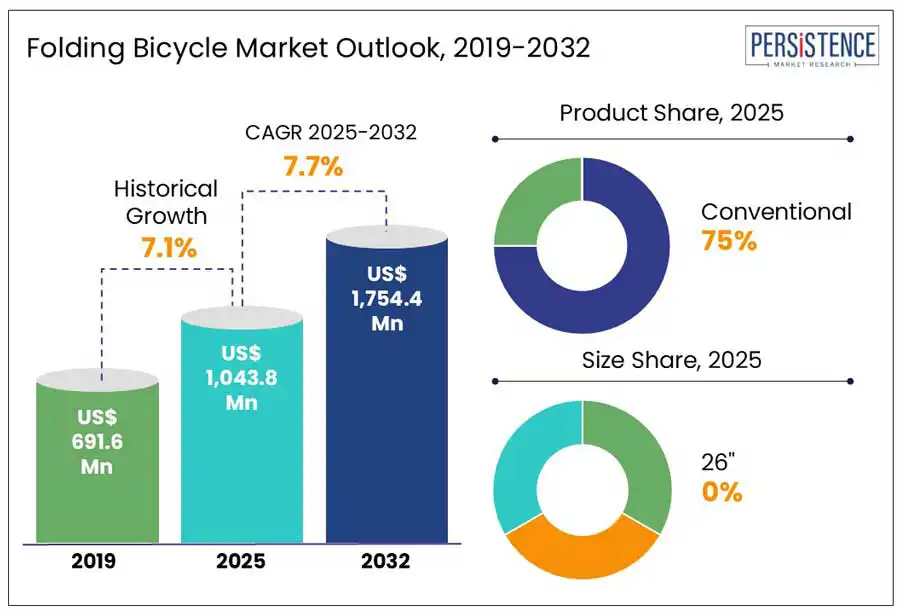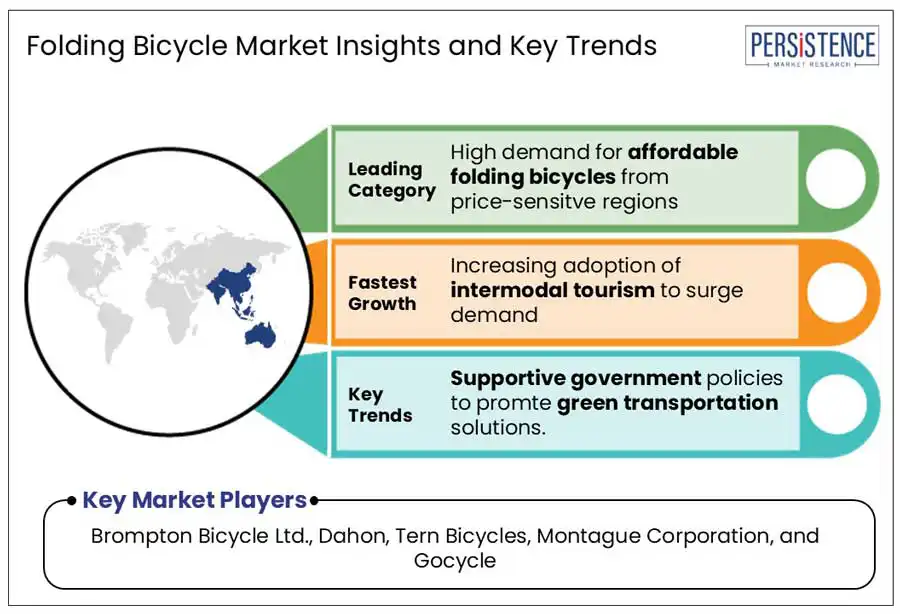Comprehensive Snapshot for Folding Bicycle Market Including Regional and Country Analysis in Brief
Industry: Automotive & Transportation
Published Date: April-2025
Format: PPT*, PDF, EXCEL
Delivery Timelines: Contact Sales
Number of Pages: 130
Report ID: PMRREP35222
The global folding bicycle market size is anticipated to be valued at US$ 1043.8 Mn in 2025. The market is projected to grow by US$ 1754.4 Mn between 2025 and 2032, at a CAGR of 7.7%. According to the Persistence Market Research report, the market is experiencing considerable growth, driven by a rising focus on micro-mobility solutions, government initiatives to develop cycling infrastructure, and high adoption of multimodal transport solutions. For instance in 2024, Velotric introduced the Fold 1 Plus, a foldable electric bike designed to enhance micro-mobility solutions for urban commuters and travelers. This model features a powerful 750W motor, a range of up to 68 miles, and foldable dimensions of 38 x 19 x 33 inches. Its compact design and robust performance cater to the growing demand for efficient, space-saving transportation options in crowded urban environments.

Key Industry Highlights
|
Global Market Attribute |
Key Insights |
|
Folding Bicycle Market Size (2025E) |
US$ 1043.8 Mn |
|
Market Value Forecast (2032F) |
US$ 1754.4 Mn |
|
Projected Growth (CAGR 2025 to 2032) |
7.7% |
|
Historical Market Growth (CAGR 2019 to 2024) |
7.1% |
The French Government’s investment of US$ 2.18billion to develop cycling infrastructure as a part of its 2023-2027 cycling and mobility plan, a testimony to an exciting road ahead. Increasing investments in developing cycling infrastructure globally are a significant factor driving market growth. Governments globally are prioritizing the development of dedicated bike lanes, secure parking facilities, and improved safety features. As cities integrate cycling into their broader mobility strategies, the demand for folding bikes is projected to grow considerably. Moreover, the development of bike-sharing schemes, improved connectivity between bike paths, and the creation of seamless cycling experiences are factors anticipated to fuel the demand for folding bikes in the forthcoming years.
High product cost remains a significant barrier to market growth, particularly in emerging and price-sensitive regions. Advanced models such as electric or those made with lightweight materials involving titanium or carbon fiber generally retail for over US$ 1,500. This high price point creates a divide, preventing a large segment of potential consumers from accessing the benefits of folding bikes. Thereby, hindering mass adoption and slowing overall market growth, particularly in emerging markets where affordable alternatives are in higher demand.
Folding bikes are emerging as a natural fit for intermodal tourism, offering seamless transitions between trains, buses, and bikes across various scenic destinations. Travelers can carry or rent foldable bikes at transit points, enabling car-free exploration of remote towns, coastlines, or countryside. Their compact design suits train luggage policies and appeals to eco-conscious, convenience-driven tourists. Moreover, this model unlocks new travel experiences while supporting sustainable tourism goals. Destinations with strong public transit networks such as Switzerland, Japan, and Netherlands, and others are integrating folding bike rentals into travel passes or hotel packages. The result is a flexible, immersive journey that benefits local businesses, reduces congestion, and aligns perfectly with the shift toward experiential, low-impact tourism. For instance, in Netherland extensive bicycle rental options are available through formal rental companies and bike-sharing apps. Many hotels offer bicycle rental services right from their service desks.
Such initiatives are anticipated to create new revenue streams for companies operating in the market during the forecast period.
Based on the product, the market is segmented into conventional and electric. Of these, the conventional segment is projected to hold an astonishing share of about 75% in 2025. Conventional foldable bikes are generally much cheaper than electric ones, making them accessible to a larger consumer base, especially in price-sensitive regions. Besides, these type of bicycles are simple to maintain, repair, and operate. Widely available with broad range of models, designs, and process, conventional bicycles are preferred by a large number of consumers globally.
On the other hand, electric segment is anticipated to witness fastest growth during the forecast period. Electric foldable bikes are perceived as a green alternative to cars or scooters among urban dwellers who want to avoid traffic and reduce emissions. In addition, technological improvements in battery life, compact design, and motor efficiency are driving the demand for electric bicycles.
On the basis of size, the 26” segment is expected to register highest revenue share in 2025. Foldable bikes with 26-inch wheels are gaining traction among recreational and adventure riders. These models offer a smoother, more stable ride ideal for touring, weekend leisure rides, and even light trail use. Their versatility and comfort makes them appealing beyond typical urban commuters, which is expected to propel their demand during the forecast period.
The 20’’ segment, on the other hand is anticipated to register substantial growth in the forthcoming years. 20’’ foldable bicycles are compact enough for easy storage and transport, while still offering a stable and comfortable ride. Their versatility makes them ideal for urban commuting, with increasing demand for compact, efficient, and eco-friendly transportation solutions.
On the basis of distribution, the offline segment is expected to dominate, driven by established retail networks, where consumers can physically test and evaluate the bikes before making a purchase. Many buyers prefer visiting stores to experience the comfort, foldability, and quality firsthand. Additionally, offline stores offer personalized consultations, after-sales services, and immediate availability, which continue to drive foot traffic and sales.
Online segment, on the other hand, is witnessing substantial growth in the forthcoming years. Online platforms provide access to a broader range of folding bikes, often at competitive prices, along with the ability to compare various models, read reviews, and benefit from home delivery. The rise of digital marketing, easy payment options, and a growing consumer base seeking convenience and contactless shopping are contributing to the rapid expansion of the online segment.

Asia Pacific is projected to hold a share of about 40% in 2025 and dominate further. With densely populated cities such as Tokyo, Beijing, and Singapore facing space constraints, folding bicycles provide a practical solution for daily commuters who require compact, portable transportation. Additionally, increasing concerns over air pollution and the adoption of green transportation policies by local governments are accelerating the adoption of foldable bicycles as a sustainable alternative to cars and motorcycles. For example, in March 2025, the Ministry of Construction in Vietnam issues a circular promoting the use of green vehicles while restricting the commute of non-compliant vehicles in designated low-emission zones. As per the latest statistics, Vietnam is currently one of the top 10 Asian countries with the highest air pollution index and further ranks 36th out of 177 global countries. The adoption of electric vehicles is aimed at combating air pollution and ensuring a smooth transition towards sustainable urban mobility.
China folding bicycle market is projected to register steady growth during the forecast period. Consumers in China are increasingly seeking affordable, space-efficient, and eco-friendly transportation solutions in crowded urban areas, making foldable bikes a practical choice. Major cities such as Shanghai and Beijing are integrating folding bicycles into their public transportation systems, while offering bike-sharing programs, which is likely to favor market growth in the country. For instance, in China, the government has introduced a substantial e-bike trade-in subsidy program, allocating US$ 137 million to encourage the replacement of older models. This initiative led to the sale of over 1.66 million new e-bikes in early 2025 alone, surpassing total sales for 2024.
Europe is anticipated to witness fast-growth fueled by growing focus on urban mobility policies, multimodal transport integration, and eco-conscious commuting. Germany is witnessing considerable growth with Deutsche Bahn allowing folding bikes on regional trains, while cities such as London and Paris encourage space-saving travel through cycling infrastructure and congestion pricing, fueling demand among urban professionals.
Product innovation is reshaping the market, with Brompton’s smart electric folding bike gaining significant traction among tech-savvy professionals in the U.K. Launched in September 2024, these bikes are manufactured using a revamped titanium frame and are integrated with a smart diagnostic app. France and the Netherlands, on the other hand, are benefitting from e-bike subsidies, while Sweden and Denmark are witnessing rising adoption of folding cargo bikes for family transport, supported by the government's car-free zone programs. These trends highlight a shift toward tech-driven, sustainable, and versatile commuting solutions.
North America is forecast to register steady growth, driven by increasing demand for last-mile connectivity and rising urban congestion. In the U.S., cities such as New York and San Francisco have expanded cycling lanes and transit compatibility, encouraging professionals to adopt folding bikes for daily commutes. Besides, the increasing number of cyclists in the U.S. and Canada is another factor driving the demand for folding bicycles in this region. According to sources, as of 2025, the U.S. has approximately 52 million bicycle riders. Increasing investment in cycling infrastructure, growing awareness regrading health benefits, and rising recreational activities are some of the factors impacting the growth of the market positively in this region.
The global folding bicycle market is experiencing intensified competition among companies in order to maintain a stronghold. Established companies such as Brompton, Dahon, Tern, and Gocycle are adopting aggressive strategies such as product discounting and product innovation to maintain their dominance. For example, in September 2024, Bromton introduced its G Line, featuring larger 20” wheels and hydraulic disc brakes, to cater to the rising demand for gravel/off-road biking trends. The market’s long-term outlook looks promising driven by increasing demand for versatile transportation solutions and environmental concerns.
|
Report Attribute |
Details |
|
Historical Data/Actuals |
2019 - 2024 |
|
Forecast Period |
2025 - 2032 |
|
Market Analysis |
Value: US$ Mn |
|
Geographical Coverage |
|
|
Segmental Coverage |
|
|
Competitive Analysis |
|
|
Report Highlights |
|
|
Customization and Pricing |
Available upon request |
By Product
By Size
By Distribution Channel
By Price Range
By Region
To know more about delivery timeline for this report Contact Sales

The global market is projected to value at US$ 1043.8 Mn in 2025.
The market is driven by supportive government policies and increasing focus on the development of cycling infrastructure globally.
The market is poised to witness a CAGR of 7.7% from 2025 to 2032.
As sustainable tourism gains traction, the integration with public transit and rising demand from eco-conscious urban dwellers are the key market opportunities.
Major players in the folding bicycle industry include Brompton Bicycle Ltd., Dahon, Tern Bicycles, Montague Corporation, and Gocycle.